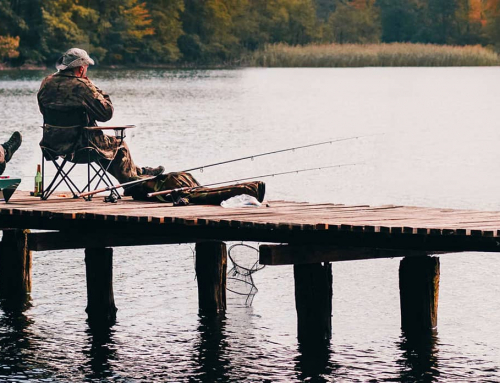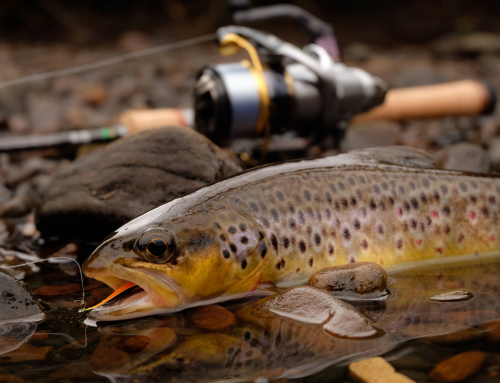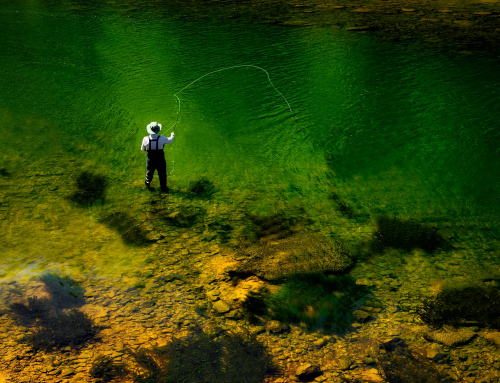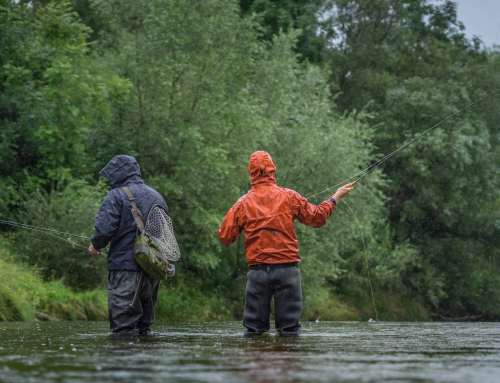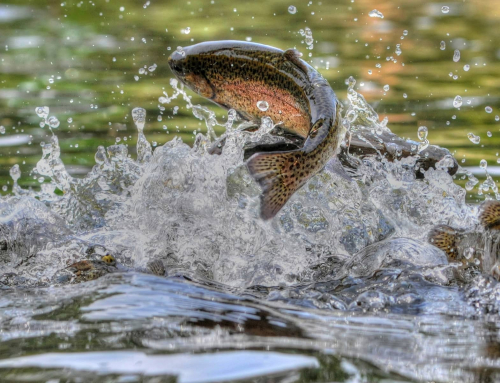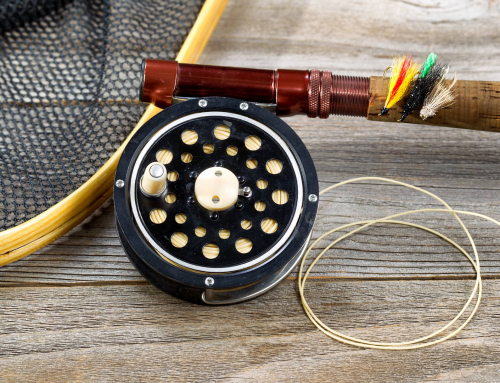We may earn money or products from the companies mentioned in this post at no additional cost to you.
The Fascinating History of Fly Fishing: From Ancient Times to Today
The history of fly fishing has long been a source of mystery and wonder. Many associate it with a leisurely day spent in nature, but the practice has been around for centuries. Fly fishing can indeed provide a respite from the busyness of everyday life; however, there are deeper meanings associated with the sport. This article will explore the rich history and cultural significance of fly fishing and how it has evolved over time.
Fly fishing is an ancient form of angling that goes back to at least the second century AD. The earliest recorded evidence suggests that it was practiced by primitive cultures in Europe and Asia for centuries before being brought to North America by European settlers in the 1600s. In recent years, this traditional pastime has seen a resurgence in popularity as more people look to reconnect with nature and experience something different from their daily lives.
Despite its growing appeal, questions remain about where fly fishing originated and why it has become so popular today. From its roots as an ancient practice to its current status as a recreational activity, this article will trace the history of fly fishing across time and place while exploring its cultural significance along the way.
Origins Of Fly Fishing
Fly fishing has been practiced for centuries, with evidence dating back to the 2nd century AD. It is believed that fly fishing was first used in Japan before being adopted by Europeans and became popularized in England during the 16th century.
The development of fly fishing as an art form can be attributed to the British, who made a number of innovations to the design and purpose of fly fishing. They developed new styles of flies and rods, as well as improved techniques for casting lines. The British also began experimenting with various types of bait, such as live bait and artificial lures, which would eventually become standard components of modern fly fishing practices. Additionally, new methods for tying knots were developed during this time period, allowing anglers greater control over where their line went. With these developments, fly fishing quickly spread worldwide and is now enjoyed by millions of people across multiple continents.
This ancient practice has grown into an extremely popular sport that continues to see advancements in equipment and techniques each year. Fly fishing is now seen as a way to connect with nature while enjoying a challenge and achieving personal freedom on the water. It is no wonder this timeless activity has continued to grow in popularity despite its long history.

Types Of Fly Fishing
Fly fishing is a popular recreational activity that involves catching fish using artificial lures. It has a long history, and numerous fly-fishing techniques have been developed over the centuries. This article will discuss the various types of fly fishing and their uses in modern times.
There are two main categories of fly fishing methods: wet and dry fly fishing. Wet flies are typically made from feathers, fur, or yarn and are designed to sit atop or just below the water’s surface. This type of fly fishing is often used to imitate aquatic insects that fish feed on. Dry flies, on the other hand, are designed to float on top of the water’s surface and resemble terrestrial insects such as grasshoppers or mayflies. This type of fly fishing is effective for attracting larger species such as trout or bass.
In addition to these two traditional methods, there are specialty techniques such as nymphing and streamer fishing. Nymphing involves tying weighted flies to a leader line, so they sink near the bottom where most fish feed. Streamer fishing uses larger flies that imitate baitfish, which can effectively target large predators like pike or musky. Each technique has its unique set of benefits depending on what kind of fish an angler is trying to catch and what conditions they may be facing while out on the water.
Whatever an angler’s preference may be, it is clear that there are many different options for fly fishing today due to technological advances and increased knowledge about the sport over time. With so many choices available, recreational fishermen can tailor their approach according to their needs and preferences to get the most out of their experience on the water.
Equipment Used For Fly Fishing
Fly fishing is an age-old pastime for anglers, and the equipment used for this type of fishing has evolved over the years. Traditional fly fishing usually involves two pieces of equipment: a rod and a reel. The rod is generally made from bamboo or fiberglass and can vary in length depending on the type of fish being sought. The reel is typically a spinning or automatic reel that allows for more precise control of the line as it is cast out into the water.
In addition to the rod and reel, other essential equipment includes flies, leaders, weights, and tippets. Flies are artificial lures that imitate natural baitfish, insects, or baitfish eggs. Leaders are made from monofilament lines and allow for a more efficient transfer of energy between the fly line and the tippet material. Weights are used to add extra heft to your cast while tippets help keep your line from getting tangled up in weeds or other debris underwater. With these essential pieces of equipment at hand, you’ll be able to confidently tackle any fresh or saltwater environment with ease.
Fly Fishing Techniques
Fly fishing is an artful technique used to capture fish and has been enjoyed by anglers for centuries. It involves using artificial flies made from fur, feathers, or yarn cast onto the water’s surface. To master this fishing method, various specialized techniques must be employed.
The first step in fly fishing is choosing the right type of fly for the conditions and species sought after. Different types of flies can be used depending on the time of year, water conditions, and type of fish being targeted. Then, anglers must determine where to cast their line based on what kind of fish they are targeting, as well as any obstacles that may be present in the water, such as lily pads or snags. Once a suitable spot is identified, the fly should be cast using a series of false casts to achieve greater accuracy and distance. The length and speed at which an angler retrieves their line are also critical when fishing with a fly rod; too slow and may not attract any attention, while too fast could cause them to miss out on a bite altogether. Lastly, an experienced angler will know how to properly set the hook when they feel a tug on their line – this requires quick reflexes and good timing!
A successful day out on the water requires patience, practice, and most importantly – knowledge! Anglers who take the time to learn about different techniques for fly fishing are more likely to find success than those who do not put in much effort upfront. With dedication and skillful execution, anyone can become a proficient fly fisherman capable of bringing home impressive catches!
Different Species Targeted By Fly Fishers
Ironically, fly fishing is not limited to just one type of fish or even a single species. In fact, the variety of species targeted by fly fishers is surprisingly large and diverse. From freshwater trout and bass to saltwater species such as striped bass, bluefish, tarpon, and bonefish, fly fishermen have a wide array of aquatic life to pursue.
No matter what type of fish they are after, anglers need to make sure they have the right equipment for their target species. Fly rods and reels can vary in size and power depending on the size of the fish being pursued. For example, a 4-weight rod with a floating line is suitable for most freshwater trout. In contrast, a 10-weight rod with a sinking line may be necessary when targeting larger saltwater gamefish like tarpon or permit. Ultimately, having the right equipment will help anglers stay in control during the fight so they can eventually land their catch safely and release it unharmed if desired.
Fly fishing offers an unparalleled experience that can bring freedom from everyday life and provide opportunities for personal growth on and off the water. It’s up to each individual angler to make sure they are adequately equipped and ready for any challenge that comes their way. With careful preparation and knowledge about the species being targeted, fly fishers can look forward to many exciting days out on the water filled with adventure and discovery.
Popular Destinations For Fly Fishing
Fly fishing is a popular pastime, and many destinations are renowned for their waters’ quality. Many anglers travel in search of the best conditions for fly fishing. The United States is among the most popular locations for recreational fly fishing.
Destinations such as Alaska, Montana, Colorado, and Oregon are famous in the U.S., each offering a unique combination of species to target and terrain to explore. In Alaska, anglers can find some of the most productive Salmon runs in the world. Montana’s rivers contain large trout that require patience, skill, and precision to catch. Colorado’s high-altitude lakes provide an opportunity to catch trophy-sized trout. Oregon has a diverse range of rivers where anglers can pursue steelhead and Salmon in addition to wild trout.
TIP: When researching your next destination for fly fishing, consider the type of species you want to target and what kind of terrain you desire most – whether it be hillside streams or alpine lakes – as this will help determine where you should go!
Consider the type of water you will be fishing – Different types of water require different types of flies. Knowing your environment can help narrow down your selection.
Research the type of fish you’ll be targeting – Different kinds of fish prefer different tube flies. Knowing what kind of food they feed on can help you pick out the perfect tube fly pattern.
Try to match the hatch – Matching the hatch is an important part of choosing the right tube fly. Look around and observe what type of insects and other aquatic creatures are in the area, then try to find a tube fly that resembles them in terms of shape, size, and color.
In addition to these tips, it is also important to take into account weather conditions and water clarity when selecting a tube fly pattern. For example, if windy or cloudy outside, using larger or darker flies may work better than small or light-colored ones. It is also important to understand how current speed affects what kind of tube fly should be used; slower currents require heavier flies, while faster currents require lighter ones. Lastly, make sure to use a variety of patterns to experiment and find out which one works best for your particular situation.
By considering all these factors when selecting a tube fly pattern, anglers can improve their chances of success on any given day on the water!
Regulations And Conservation Practices
Fly fishing is an activity of remarkable beauty and complexity. As a centuries-old practice, it has become increasingly popular around the world. However, with this increasing popularity also come certain responsibilities, particularly concerning regulations and conservation practices.
The importance of adhering to these regulations cannot be understated:
Respect for private property
Observing catch limits and size restrictions
Promoting sustainable practices
Minimizing environmental impact
By following the above regulations and conservation practices, fly fishermen can ensure that their activities remain sustainable over time. This helps preserve the delicate balance of natural resources, ensuring that future generations can enjoy the same wonderful experience that many cherish today. Moreover, it provides an opportunity for fly fishermen to take ownership of their sport – not just to participate in it but to contribute to its success and enjoyment for everyone. In doing so, they demonstrate respect for nature and help to protect its fragile beauty.
Popularity Of Fly Fishing Over Time
Fly fishing has enjoyed a long and illustrious history, with its popularity waxing and waning over time. It is no surprise then that in the modern era, this traditional activity continues to capture the hearts and minds of many. By examining the popularity of fly fishing throughout history, we can gain insight into not only how it has been viewed but also why it remains so beloved by so many.
Satirically speaking, fly fishing can be seen as a great way to escape the trappings of everyday life. Its tranquil surroundings offer a reprieve from the hustle and bustle of modern life. People have been drawn to this pastime for centuries due to its relaxing nature and ability to bring them closer to nature. It also provides ample opportunity for socialization; people have participated in fly fishing competitions since Roman times when competitions were held on the Thames River.
Throughout the history of fly fishing, there have been fluctuations in the popularity of fly fishing; however, it remains a popular activity today. This could be attributed to several factors, such as improved access to equipment, increased acceptance of catch-and-release practices, and more comprehensive regulations which encourage conservation efforts. Additionally, advances in technology have made it easier than ever before for anglers to find their perfect spot on streams or rivers around the world. As a result, more people can experience this timeless tradition that has captivated enthusiasts for generations.
Impact Of Technology On Fly Fishing
The lure of fly fishing is as magical as ever – its ebb and flow enchanting the angler with a sense of adventure, exploration, and freedom. Technology has greatly impacted this ancient sport, revolutionizing it in ways that were once unthinkable.
The advancement of technology has allowed for more efficient and precise rods, reels, lines, and lures. In addition:
- Fishing-specific apps track weather patterns, moon phases, tide levels, and fish behavior to maximize the likelihood of success.
- High-tech materials have been introduced which allow for lighter-weight gear that is stronger and more durable than ever before.
- GPS tracking systems allow fishermen to mark their favorite spots on their devices so they can easily return to them next time they are out on the water.
With these technological advancements at our fingertips, fly fishing enthusiasts can enjoy improved accuracy and precision while still getting lost in the beauty of nature’s elements – wind direction, temperature changes, or current water shifts – all while casting out into the unknown. This newfound freedom gives fishermen a higher level of confidence and success on the water – allowing them to make the most out of every outing.
Social Aspects Of Fly Fishing
Fly fishing has been an important part of recreational and competitive sports for centuries. A recent survey revealed that more than 8 million individuals in the United States alone participate in fly fishing annually. This indicates the immense popularity and widespread reach of this sport.
The social aspect of fly fishing is just as essential as its technical aspects. It is a great way to enjoy nature while also engaging in friendly competition with fellow anglers. Additionally, it serves as a form of relaxation and therapy for many people. Fly fishing groups can be found all over the world, giving people an opportunity to share knowledge and experiences about their passion for this activity. Through these groups, friendships are created, stories are exchanged and shared, and a sense of camaraderie is fostered among those who take part in this sport.
Fly fishing is thus more than just a sport; it is an experience that enables people to connect with nature while forming meaningful relationships with like-minded individuals. Its popularity continues to increase year after year, further proving its significance in our lives as well as its potential to bring people together from different backgrounds.
Economic Benefits Of Fly Fishing
Fly fishing has become a popular pastime and sport in many parts of the world, providing economic benefits to the industry and local economies. Fly fishing is a unique form of angling that requires skillful technique and specialized equipment which can be purchased from shops, online stores, and other retail outlets. This has created an array of opportunities for businesses to profit from selling necessary items such as rods, reels, lines, lures, and clothing. Additionally, fishing trips and guided tours provide another source of income to guides who are knowledgeable about the local area.
The economic impact of fly fishing goes beyond sales at retail stores and income for guides. Local businesses can benefit from increased tourism to nearby areas known for their fishing opportunities. Anglers spend money on food, lodging, transportation, and other goods while visiting these locations. This influx of extra revenue into local economies helps create jobs and stimulate growth in the community. Moreover, increased activity on streams often leads to greater conservation efforts in order to protect water quality as well as fish populations which in turn contributes to a healthier environment.
Fly fishing has become much more than just an enjoyable hobby; it has significant positive impacts on the economy both directly through sales and indirectly through tourism-related activities. These effects have been seen around the world as people engage in this rewarding sport and experience its many benefits firsthand.
Innovations In Fly Fishing
As a river of opportunity flows ever onwards, those who have chosen to go fly fishing have been presented with an array of innovations. From the first use of the artificial fly in the eighteenth century to the latest advancements in technology, fly fishing has constantly evolved.
The introduction of new materials for creating artificial flies and modern developments in rods and reels have revolutionized how this once-traditional sport is practiced today. New inventions such as weight-forward tapers, floating lines, and graphite rods have allowed skilled anglers to cast further and more accurately than ever before. The development of specialized wading gear, such as breathable waders and synthetic boots, has also enabled fishermen to explore rivers and streams with greater ease.
In addition to the technological advances made, there has also been a push for conservation efforts by professional organizations dedicated solely to fly fishing. Adopting catch-and-release practices has helped maintain a healthy population of fish species while allowing anglers to enjoy their sport responsibly. Overall, these innovations have created an exciting time for both newbies and experienced fishermen alike as they explore the wonders that lie beneath the surface of our waters.
Professional Fly Fishing Organizations
Fly fishing has been around for centuries, and as the passion for this sport has grown, so too have many professional organizations dedicated to it. These organizations grant a sense of unity among fly fishermen and provide unique opportunities to those who take part in them. Like a beacon of light guiding anglers on their way, these organizations can open doors that would otherwise remain closed.
As times have changed, so too has the landscape of fly fishing organizations. In modern times, there are numerous groups that offer membership for competitive and recreational anglers alike. From international clubs to regional clubs that focus on specific species or types of fishing, these organizations create spaces where anglers can share experiences and learn from one another. Many also offer educational programs such as seminars and workshops designed to increase knowledge about the sport and its various techniques. Additionally, members have access to exclusive discounts on gear and travel packages that help make fly fishing more affordable for everyone involved.
In essence, professional fly fishing organizations offer an invaluable service to those interested in the sport by providing an outlet for learning, networking, and participating in competitions. They are an excellent resource for connecting with other passionate anglers and building a sense of community within the fly fishing realm. By joining forces with others who share your enthusiasm for the sport, you can expand your horizons while gaining insight into different methods of fishing – all while having fun!
Challenges Faced By Fly Fishers
A well-known saying goes, “where there is a will, there is a way.” This proverb holds true when it comes to fly fishing. Despite the many advances in technology and technique that have made fly fishing more enjoyable, fishers still face numerous challenges.
From casting and mending lines to selecting the correct type of fly, anglers must be knowledgeable about maximizing their chance of success on the water. Oftentimes, conditions can change quickly while out fishing, making it difficult for anglers to make informed decisions in a timely fashion. Furthermore, improper technique can often lead to the tangling of lines or missed opportunities with fish.
The complexity of the sport has inspired many people to pursue a deeper understanding of the craft through practice and experience. Although fly fishing presents plenty of difficulties for those new to the sport, mastering these challenges can lead to a feeling of accomplishment and an increased appreciation for nature’s beauty. Developing an understanding of fly fishing’s nuances can also give fishermen greater control over their experience on the water, resulting in more successful outings and a more profound sense of freedom within the natural environment.
Future Of Fly Fishing
The future of fly fishing holds immense potential. As the sport continues to gain popularity, new and innovative methods are being developed to make it more accessible and enjoyable. With the right tools, techniques, and attitudes, fly fishing can become a sustainable activity for generations to come.
Fly fishing has abundant benefits that can be enjoyed by anglers of all ages. Here are a few ways the future of fly fishing could look:
- Increased access to suitable waterways, making it easier for people to get out into nature and enjoy the sport.
- More efficient gear that is better suited for different types of water conditions and fish species.
- Greater support from local governments in terms of resources for education and conservation efforts.
- An overall culture shift towards sustainability and respect for our natural environment.
These changes could lead to a rise in the number of people taking up fly fishing as a hobby or recreational activity, which would result in improved economic opportunities in areas where it is popular. It could also help foster an appreciation for nature amongst younger generations, encouraging them to take part in outdoor activities such as fly fishing while also looking after their environment. So the future looks bright for this beloved pastime – one that will provide countless hours of enjoyment whilst connecting us with nature like never before.
FAQ
Final thoughts on Tube Flies
Fly fishing is a method of angling that has been used for centuries to catch fish in freshwater and saltwater environments. Fly fishing differs from other fishing methods in that the angler uses a floating line, weighted fly, and a rod and reel to cast the fly. The line is usually weighted so that it can be cast upstream, and the weight of the fly helps it to sink quickly.
The ancient Egyptians were the first to use artificial flies made of feathers and other materials. These flies were used to attract fish and are known as “flies” to this day.
In the 16th century, Europeans began to use artificial flies. They began to develop the technique of casting them upstream to catch fish. This technique became known as “fly fishing.”
In the 19th century, the invention of the reel revolutionized fly fishing by allowing anglers to cast longer distances and control the speed of the line. This allowed for more accurate casting and the ability to catch larger fish.
Fly fishing has become a popular sport and is practiced worldwide by anglers of all ages and skill levels. There are many different types of flies, rods, and reels available to fly fishers. Fly fishing has also become a popular form of competition, with various yearly tournaments.
Stay tuned for our upcoming article on the best fishing line for trout! Or, check out our blog on Best Telescopic Fish Rods.
